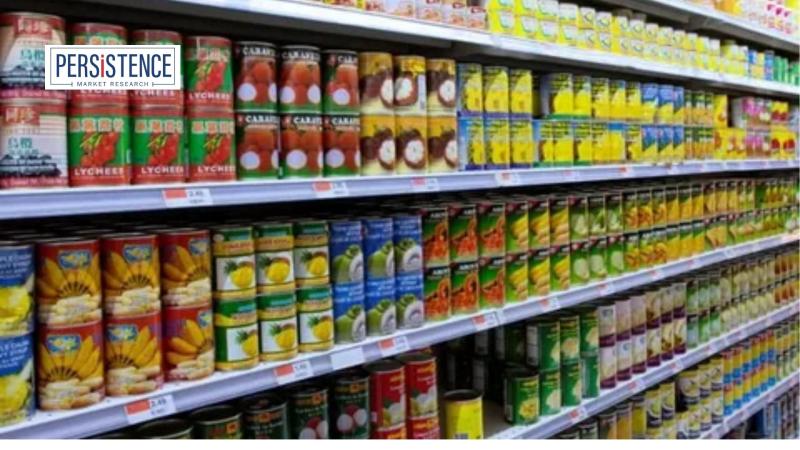 The global canned food market continues to register steady growth, driven by consumer demand for convenient, long-lasting, and nutritious meal options. In 2024, the market size is valued at US$91.2 Bn and is projected to grow to US$120.8 Bn by 2031, exhibiting a CAGR of 4.1% from 2024 to 2031. Canned foods remain a staple in global households, owing to their ease of preparation, extended shelf life, and affordability.
The global canned food market continues to register steady growth, driven by consumer demand for convenient, long-lasting, and nutritious meal options. In 2024, the market size is valued at US$91.2 Bn and is projected to grow to US$120.8 Bn by 2031, exhibiting a CAGR of 4.1% from 2024 to 2031. Canned foods remain a staple in global households, owing to their ease of preparation, extended shelf life, and affordability.
Modern consumer trends, such as the demand for healthier, organic alternatives and heightened interest in food sustainability, are reshaping the canned food industry. With increasing emphasis on low-sodium, preservative-free, and organic variants, brands are innovating to appeal to health-conscious buyers.
Get a Sample PDF Brochure of the Report (Use Corporate Email ID for a Quick Response):
https://www.persistencemarketresearch.com/samples/34527
The canned seafood segment dominates the market due to high consumer preference, nutritional value, and long shelf life. Regionally, North America leads the global canned food market, driven by product innovation, widespread retail networks, and evolving consumer preferences that favor convenient, ready-to-eat meals.
Key Highlights from the Report
➤ The canned food market is anticipated to grow at a CAGR of 4.1% between 2024 and 2031.
➤ North America continues to be the largest market due to advanced distribution and strong consumer demand for convenience foods.
➤ Canned seafood remains the leading segment due to versatility and sustainable sourcing initiatives.
➤ Supermarkets and hypermarkets are the most preferred distribution channel among consumers.
➤ Demand for clean-label, organic, and low-sodium canned products is significantly rising.
➤ Plant-based and ethnic canned meal offerings are creating new revenue opportunities.
Market Segmentation
The canned food market is segmented by type, product, distribution channel, and region. By type, it includes canned seafood, vegetables and fruits, meat, and others. In terms of product, the market covers canned meat and seafood, fruits and vegetables, and ready meals. Distribution channels encompass supermarkets/hypermarkets, specialty stores, and online retail. Regionally, the market includes North America, Europe, Asia Pacific, East Asia, South America, and the Middle East & Africa.
Regional Insights
In North America, the canned food market thrives due to rapid urbanization, robust supply chains, and a strong emphasis on organic and health-conscious products. The United States, in particular, leads with innovative offerings and strong consumer trust in canned brands.
Europe holds a significant share, benefiting from longstanding consumer habits, sustainable packaging initiatives, and seasonal limitations that favor preserved produce. European consumers demand high-quality, GMO-free, and eco-friendly products.
Asia Pacific is witnessing growing consumption, fueled by population growth, rapid urban development, and increasing demand for affordable and shelf-stable food options. Countries like China and India are central to the region’s growing influence in this market.
Market Drivers
Health awareness and demand for organic, preservative-free canned goods are reshaping consumer preferences. Canned foods are becoming synonymous with nutritional value and accessibility. Convenience remains a key driver, especially for urban populations, dual-income families, and smaller households seeking quick meal solutions. Shifts in lifestyle patterns are encouraging the rise of portion-controlled, on-the-go snacks, further boosting the market.
Market Restraints
Despite its benefits, the canned food industry faces challenges related to environmental concerns. Metal can production and disposal, while recyclable, still contribute to carbon emissions. The perception of canned foods being less fresh than natural produce also hampers market expansion, particularly among premium consumer segments.
Market Opportunities
Manufacturers have the opportunity to expand product portfolios by introducing plant-based and global cuisine-inspired canned foods. Offering gourmet options and sustainable packaging solutions aligns with the increasing consumer appetite for eco-conscious and ethically sourced products. As online retail expands, digital platforms present new avenues for targeted marketing and direct-to-consumer sales.
Get a Sample PDF Brochure of the Report (Use Corporate Email ID for a Quick Response):
https://www.persistencemarketresearch.com/samples/34527
Frequently Asked Questions (FAQs)
◆ How big is the global canned food market in 2024 and what is its forecast for 2031?
◆ Who are the key players in the global market for canned food?
◆ What is the projected CAGR of the canned food market through 2031?
◆ What are the major trends impacting the canned food market?
◆ Which region is estimated to dominate the industry through the forecast period?
Company Insights
• Del Monte Foods, Inc
• JBS USA Holdings, Inc.
• Campbell Soup Company
• Danish Crown AmbA
• AYAM SARL
• Bumble Bee Foods, LLC
• Nestlé S.A
• Bolton Group S.r.l.
• General Mills, Inc
Contact Us:
Persistence Market Research
G04 Golden Mile House, Clayponds Lane
Brentford, London, TW8 0GU UK
USA Phone: +1 646-878-6329
UK Phone: +44 203-837-5656
Email: sales@persistencemarketresearch.com
Web: https://www.persistencemarketresearch.com
About Persistence Market Research:
At Persistence Market Research, we specialize in creating research studies that serve as strategic tools for driving business growth. Established as a proprietary firm in 2012, we have evolved into a registered company in England and Wales in 2023 under the name Persistence Research & Consultancy Services Ltd. With a solid foundation, we have completed over 3600 custom and syndicate market research projects, and delivered more than 2700 projects for other leading market research companies’ clients.
Our approach combines traditional market research methods with modern tools to offer comprehensive research solutions. With a decade of experience, we pride ourselves on deriving actionable insights from data to help businesses stay ahead of the competition. Our client base spans multinational corporations, leading consulting firms, investment funds, and government departments. A significant portion of our sales comes from repeat clients, a testament to the value and trust we’ve built over the years.
This release was published on openPR.